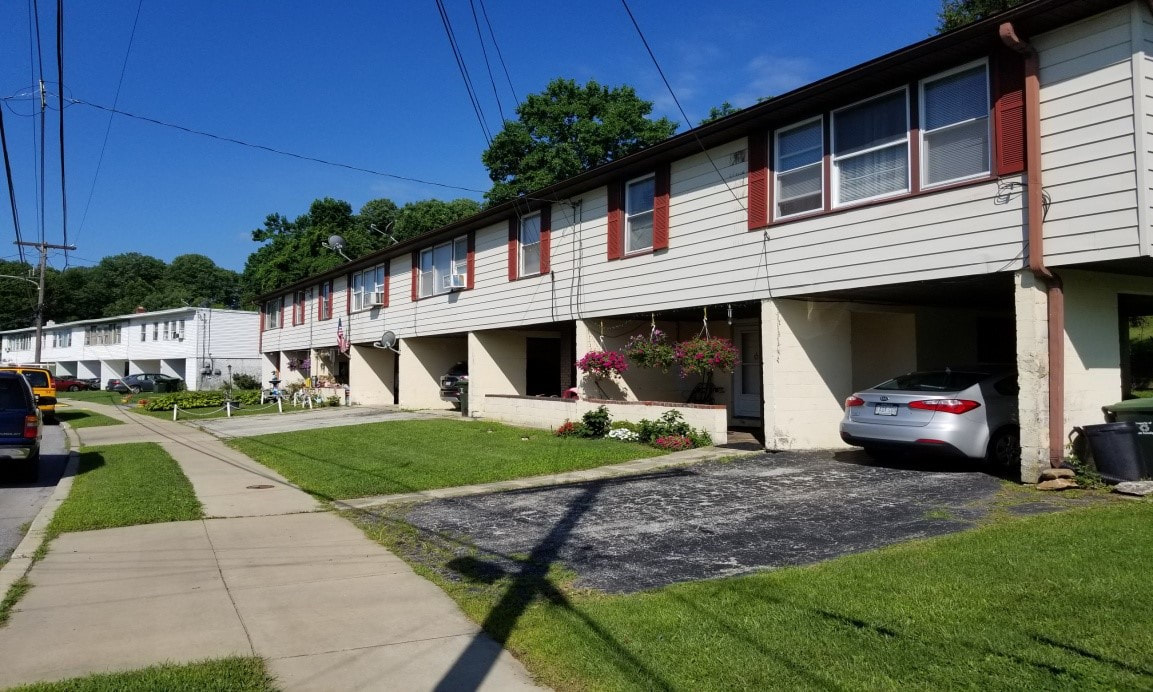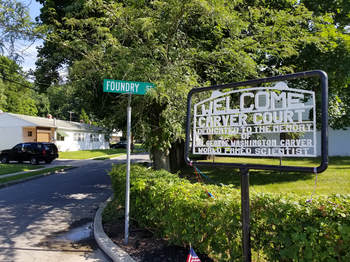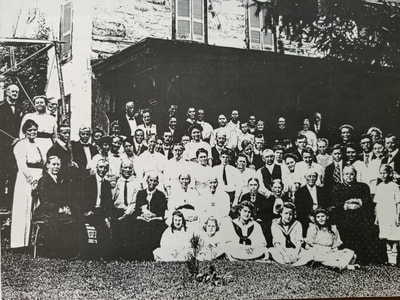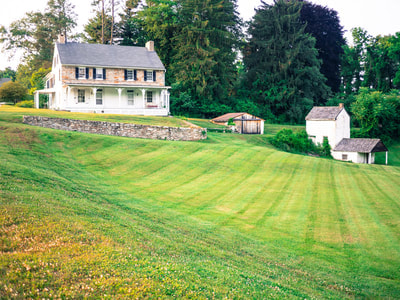Sample Histories
The 4 properties below, Carver Court, Davis-Spackman, G. O. Carlson and the Hexagonal School House, represent some of the very interesting and diverse stories associated with Caln Township. Each is only a small sample of the research available from our free database. From famous architects building creative homes for steelworker minorities, to the underground railroad families committed to the freedom of all men, to the excitement of a potential gold rush and the origin of Caln Township's official symbol, these preserved histories connect us to our past and give us inspiration for our future.
Carver Court
Three giants of modern architecture in Philadelphia–George Howe, Louis I. Kahn, and Oskar Stonorov–collaborated on this Federal housing project built for African American defense workers and their families just outside Coatesville during World War II. A former race track was converted into a landscaped cul-de-sac encircling a common green space, lined with 100 units of one- and two-story International Style homes. Carver Court, originally named Foundry Street Defense Housing, is no ordinary house by virtue of its users, some of which are the original African-American steelworkers. If it were up to Kahn, Carver Court would not have been segregated. Race politics at this Pennsylvania mill town necessitated the residential division between black and white workers, even though both groups worked for the same Lukens Steel factory. It is only one of five housing projects designed by Kahn, Storonov, and Howe, and is the single specimen of their African-American architecture. Carver Court has slipped the radar of preservationists and historians because it looks nondescript and lacks the telltale signs of high modernist distinction. Its ordinariness, however, is what makes it exemplary. Taking cues from Le Corbusier, Kahn invented a scheme of adoptive design that reinterpreted the traditional row house. His “ground-freed” housing form elevated living quarters to the second floor and left the first floor open to the owner’s specific interpretation. Rather than limiting what the owners did with their allotted housing unit, Kahn wanted the occupants to exercise some freedom in how to use the first floor. It could function as a garage, a workshop, or added living space.
Pa. State Representative Harry Lewis said “My father worked at Lukens Steel, so my family had a home in Carver Court. The complex had a tremendous community spirit, and my siblings and I loved growing up there. I was honored to work to add Carver Court to the National Registry of Historic Places, and I thank Jane Kennedy, who has been instrumental in assisting with the effort.”
Pa. State Representative Harry Lewis said “My father worked at Lukens Steel, so my family had a home in Carver Court. The complex had a tremendous community spirit, and my siblings and I loved growing up there. I was honored to work to add Carver Court to the National Registry of Historic Places, and I thank Jane Kennedy, who has been instrumental in assisting with the effort.”
Davis-Spackman Farm
The Sept 1913 reunion of the Spackman family was held on Saturday with the family assembling in the old mansion, near the Caln Meeting House, which for more than a century has sheltered its members.
Isaac Spackman purchased the 145 acre property in 1785. That deed recorded a log house of 1 ½ stories, a log barn, a sawmill, a wheelwright shop and four small log outbuildings. The 1802 tax records assessed him for a log and stone house.
The Spackmans were at least partially involved in the Underground Railroad as a runaway slave, Richard Gibbs, who was working at the Gravner Marsh farm (see also) was suddenly confronted by his former master. Gibbs “put his hands upon a fence close by, leaped it and ran down a hill toward a grove along side of which was Beaver Creek … When he reached the fence at the foot of the hill the men were but a few feet behind him; but he sprang for the top rail, tumbled over it with a somersault, ran through a creek and into a thicket of grape vines and briers where he disappeared from their sight . . .
He went to Thomas Spackman’s, where he was safely ensconced.” Spackman and Marsh later provided him with funds and arranged for him to leave the neighborhood for a safer refuge.
Thomas Spackman died in 1846. His son Isaac inherited the land and later turned it over to his daughter Amanda (see Chestnut Dell School), who stayed at the farm until her death at age 89 in 1924. The property briefly left the family for ten years in 1926, but was reacquired by a Spackman descendant Penrose Davis, President of the Downingtown Iron Works and a Coatesville School Board member, who named the farm Penncroft. In December 2005, the property was transferred by Penrose Davis’ grandchildren, Marianne and Theodore Griffith, to Caln Township for $550,000. The Spackman family owned the farm for a Caln Township single lineage record of 220 years.
Isaac Spackman purchased the 145 acre property in 1785. That deed recorded a log house of 1 ½ stories, a log barn, a sawmill, a wheelwright shop and four small log outbuildings. The 1802 tax records assessed him for a log and stone house.
The Spackmans were at least partially involved in the Underground Railroad as a runaway slave, Richard Gibbs, who was working at the Gravner Marsh farm (see also) was suddenly confronted by his former master. Gibbs “put his hands upon a fence close by, leaped it and ran down a hill toward a grove along side of which was Beaver Creek … When he reached the fence at the foot of the hill the men were but a few feet behind him; but he sprang for the top rail, tumbled over it with a somersault, ran through a creek and into a thicket of grape vines and briers where he disappeared from their sight . . .
He went to Thomas Spackman’s, where he was safely ensconced.” Spackman and Marsh later provided him with funds and arranged for him to leave the neighborhood for a safer refuge.
Thomas Spackman died in 1846. His son Isaac inherited the land and later turned it over to his daughter Amanda (see Chestnut Dell School), who stayed at the farm until her death at age 89 in 1924. The property briefly left the family for ten years in 1926, but was reacquired by a Spackman descendant Penrose Davis, President of the Downingtown Iron Works and a Coatesville School Board member, who named the farm Penncroft. In December 2005, the property was transferred by Penrose Davis’ grandchildren, Marianne and Theodore Griffith, to Caln Township for $550,000. The Spackman family owned the farm for a Caln Township single lineage record of 220 years.



